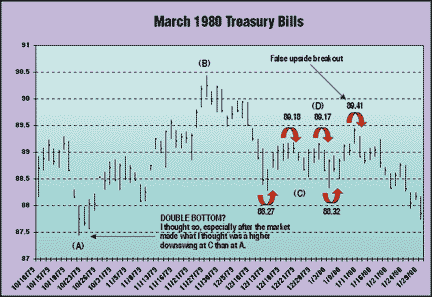WAR STORY
The Highs And Lows Of Trading
by Edward Robert Florez
Here's a war story that illustrates some mistakes that all traders have made at one time or another -- and should keep in mind.
The best-laid plans and analysis can become catastrophically skewed when conditions change and you do not lessen your risk. Back in 1980, during President Jimmy Carter's last year in office, speculation was rampant that interest rates would have to go down in order to benefit the President's reelection campaign. By then, interest rates had already had a dramatic and unprecedented rise.

FIGURE 1: DOUBLE BOTTOM? We all see what we think we see. Was this a double bottom putting the market in position to rally? It wasn't.
A year or so before the November 1980 election, in an event referred to as "the Saturday night massacre," Federal Reserve chairman Paul Volcker raised the discount rate by two percent points over a weekend. He also ordered massive intervention in the foreign exchange market in support of the dollar, and effectively adopted monetarism as policy by which the Fed would manage the money supply and hence the economy. This sent shock waves through the international monetary system and ushered in a new era of trading. It is the foundation upon which a great deal of today's speculative trading is still focused.
As it turned out, interest rates didn't top out for another year and a half. But by January 1980, interest rates were high enough to convince a number of traders that they were bound to change direction.
Incidentally, all interest rate futures trade backward in a way: They will always trade exactly the opposite of the direction that interest rates go. If interest rates are rising, all Treasury bills, Eurodollars, bond and note futures prices will decline. Just the opposite occurs when interest rates decline; the prices for T-bills and all the other interest rate futures contracts will rally when interest rates drop.
Back then, the 90-day Treasury bill futures was the most active short-term interest rate contract, though a few years later they lost their appeal to the Eurodollar contract. This is what happened to me in the Treasury bill market during January and February 1980.
WHAT HAPPENED
I have always been a broker, which is one of the reasons why I was on the trading floor at the Chicago Mercantile Exchange (CME) at that time. There, I was closer to the source of the final exchange of ideas, money, and motivation. I was starting to trade well, some as a result of my own analysis and some based on fundamental information and rumors. It was a rumor that really got me into trouble. I simply didn't play it properly.
Until this time, I had made most of my speculative profits by making long-term investment strategies without leverage. If I were certain that a market -- like gold, for instance -- was going to make a significant upswing, I would buy gold coins. But I was so convinced that a trend change in interest rates was going to occur, I went for broke and took a huge long position in T-bills. If you look at Figure 1, you can see what appeared to be the potential formation of a double bottom at point C. This occurred between December 13, 1979, and January 3, 1980.
Bobby Florez has been a professional trader, analyst, broker, and author for almost three decades. He retired from the Chicago Board of Trade in 1996 and now devotes his time helping others learn how to trade. He offers lessons online at https://www.synchronomics.com/.
Excerpted from an article originally published in the March 2000 issue of Technical Analysis of STOCKS & COMMODITIES magazine. All rights reserved. © Copyright 2000, Technical Analysis, Inc.
Return to March 2000 Contents